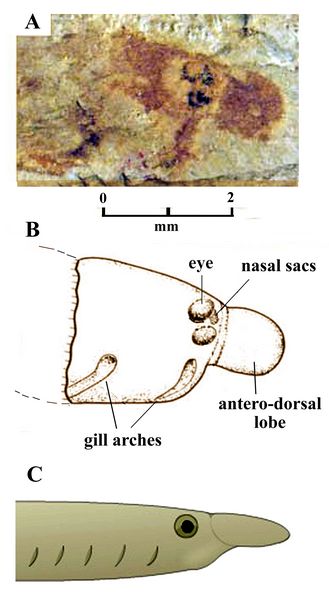Athena Review Image Archive ™
Zhongjianichthys rostratus

Zhongjianichthys rostratus (after Shu 2003).
.
Zhongjianichthys rostratus was an Early to Middle Cambrian chordate found in Yunnan, China, dating from 535-520 mya. It was discovered in the Jianshan beds, near Dianchi Lake, in the Qiongzhusi Formation of Yunnan, China. It is named Zhongjian- for the paleontologist Zhongjian Yang, and -ichthys "fish". The species name rostratus is for its characteristic rostral lobe. It belongs to the phylum Chordata, the class Agnatha (jawless), and the order Myllokunmingiida.
The holotype (ELI-000160 at the Early Life Institute of Northwest Univ. Xi`an) includes a total of five specimens identified as of 2003. Its body ( 2-3 cm long) was small, elonged, and eel-like in form. The top or dorsal surface of the head extends forward in a rostral lobe 1.0 - 1.2 mm long. The eyes are behind the lobe, along with a pair of tiny nasal sacs. It has at least 5 pairs of gill arches.
Zhongjianichthys is similar to Haikouichthys,
although it has a longer anterior or rostral lobe, with its eyes behind
lobe instead of within it, and a more elongated body with less
developed dorsal and ventral fins. More advanced features for Z. rostratus
include the posterior eye location, and the absence of muscle
impressions (myomeres), indicating a thicker skin, as in modern lamprey
and hagfish.
References:
Shu Degan 2003. Chinese Science Bull. vol 48; pp.725-735
Copyright © 1996-2020 Rust Family Foundation (All Rights Reserved).